Cyclodextrin Rotaxanes of Pt Complexes and Their Conversion to Pt Nanoparticles
Abstract
1. Introduction
2. Results and Discussion
2.1. Preparation and Characterization of the Cyclodextrin Rotaxanes of the Pt Complex
2.2. Preparation of Pt Nanoparticles
3. Materials and Methods
3.1. General
3.2. Preparation of [4,4′-bpy-N-(CH2)12OC6H3-3,5-(OMe)2][Br] ([1]+Br−) and [4,4′-bpy-N-(CH2)12OC6H3-3,5-(OMe)2][NO3] ([1]+(NO3) −)
3.3. Preparation of [Pt(Me5dien)Cl]Cl ([2]Cl)
3.4. Preparation of [Pt(Me5dien)(4,4′-bpy-N-(CH2)12OC6H3-3,5-(OMe)2)][NO3]3 ([3](NO3))
3.5. Rotaxane of α-CD with [Pt(Me5dien)(4,4′-bpy-N-(CH2)12OC6H3-3,5-(OMe)2)][NO3]3)
3.6. Rotaxane of β-CD with [Pt(Me5dien)(4,4′-bpy-N-(CH2)12OC6H3-3,5-(OMe)2)][NO3]3)
3.7. Rotaxane of γ-CD with [Pt(Me5dien)(4,4′-bpy-N-(CH2)12OC6H3-3,5-(OMe)2)][NO3]3
3.8. Reduction of Pt Complex and Its Rotaxanes
4. Conclusions
Author Contributions
Funding
Acknowledgments
Conflicts of Interest
References
- Chen, A.; Holt-Hindle, P. Platinum-Based Nanostructured Materials: Synthesis, Properties, and Applications. Chem. Rev. 2010, 110, 3767–3804. [Google Scholar] [CrossRef] [PubMed]
- Sharma, R.K.; Sharma, P.; Maitra, A. Size-dependent Catalytic Behavior of Platinum Nanoparticles on the Hexacyanoferrate(III)/Thiosulfate Redox Solution. J. Colloid Interface Sci. 2003, 265, 134–140. [Google Scholar] [CrossRef]
- Lee, H.; Habas, S.E.; Kweskin, S.; Bucher, D.; Somorjai, G.A.; Yang, P. Morphological Control of Catalytically Active Platinum Nanocrystals. Angew. Chem. Int. Ed. 2006, 45, 7824–7828. [Google Scholar] [CrossRef] [PubMed]
- Wu, G.-W.; He, S.-B.; Peng, H.-P.; Deng, H.-H.; Liu, A.-L.; Lin, X.-H.; Xia, X.-H.; Chen, W. Citrate-Capped Platinum Nanoparticle as a Smart Probe for Ultrasensitive Mercury Sensing. Anal. Chem. 2014, 86, 10955–10960. [Google Scholar] [CrossRef]
- Wang, Y.; Toshima, N. Preparation of Pd-Pt Bimetallic Colloids with Controllable Core/Shell Structures. J. Phys. Chem. B 1997, 101, 5301–5306. [Google Scholar] [CrossRef]
- Shiraishi, Y.; Nakayama, M.; Takagi, E.; Tominaga, T.; Toshima, N. Effect of Quantity of Polymer on Catalysis and Superstructure Size of Polymer-protected Pt Nanoclusters. Inorg. Chim. Acta 2000, 300, 964–969. [Google Scholar] [CrossRef]
- Luo, M.; Hong, Y.; Yao, W.; Huang, C.; Xu, Q.; Wu, Q. Facile Removal of Polyvinylpyrrolidone (PVP) Adsorbates from Pt Alloy Nanoparticles. J. Mater. Chem. A 2015, 3, 2770–2775. [Google Scholar] [CrossRef]
- Zou, F.; Zhou, J.; Zhang, J.; Li, J.; Tang, B.; Chen, W.; Wang, J.; Wang, X. Functionalization of Silk with In-Situ Synthesized Platinum Nanoparticles. Materials 2018, 11, 1929. [Google Scholar] [CrossRef]
- Watanabe, A.; Kajita, M.; Kim, J.; Kanayama, A.; Takahashi, K.; Mashino, T.; Miyamoto, Y. In Vitro Free Radical Scavenging Activity of Platinum Nanoparticles. Nanotechnology 2009, 20, 455105. [Google Scholar] [CrossRef]
- Guo, G.; Qin, F.; Yang, D.; Wang, C.; Xu, H.; Yang, S. Synthesis of Platinum Nanoparticles Supported on Poly(acrylic acid) Grafted MWNTs and Their Hydrogenation of Citral. Chem. Mater. 2008, 20, 2291–2297. [Google Scholar] [CrossRef]
- Witham, C.A.; Huang, W.; Tsung, C.K.; Kuhn, J.N.; Somorjai, G.A.; Toste, F.D. Converting Homogeneous to Heterogeneous in Electrophilic Catalysis Using Monodisperse Metal Nanoparticles. Nat. Chem. 2010, 2, 36–41. [Google Scholar] [CrossRef] [PubMed]
- Schill, G. Catenanes, Rotaxanes, and Knots, 1st ed.; Aademic Press: New York, NY, USA, 1971. [Google Scholar]
- Amabilino, D.B.; Stoddart, J.F. Interlocked and Intertwined Structures and Superstructures. Chem. Rev. 1995, 95, 2725–2828. [Google Scholar] [CrossRef]
- Jäger, R.; Vögtle, F. A New Synthetic Strategy towards Molecules with Mechanical Bonds: Nonionic Template Synthesis of Amide-Linked Catenanes and Rotaxanes. Angew. Chem. Int. Ed. Engl. 1997, 36, 930–944. [Google Scholar] [CrossRef]
- Chambron, J.-C.; Sauvage, J.P. Functional Rotaxanes: From Controlled Molecular Motions to Electron Transfer between Chemically Nonconnected Chromophores. Chem. A Eur. J. 1998, 4, 1362–1366. [Google Scholar] [CrossRef]
- Hubin, T.J.; Busch, D.H. Template Routes to Interlocked Molecular Structures and Orderly Molecular Entanglements. Coord. Chem. Rev. 2000, 200, 5–52. [Google Scholar] [CrossRef]
- Takata, T.; Kihara, N. Rotaxanes Synthesized from Crown Ethers and sec-Ammonium Salts. Rev. Heteroat. Chem. 2000, 22, 197–218. [Google Scholar] [CrossRef]
- Erbas-Cakmak, S.; Leigh, D.A.; McTernan, C.T.; Nussbaumer, A.L. Artificial Molecular Machines. Chem. Rev. 2015, 115, 10081–10206. [Google Scholar] [CrossRef]
- Kim, K. Mechanically Interlocked Molecules Incorporating Cucurbituril and their Supramolecular Assemblies. Chem. Soc. Rev. 2002, 31, 96–107. [Google Scholar] [CrossRef]
- Collin, J.-P.; Sauvage, J.-P. Transition Metal-complexed Catenanes and Rotaxanes as Light-driven Molecular Machines Prototypes. Chem. Lett. 2005, 34, 742–747. [Google Scholar] [CrossRef]
- Leigh, D.A.; Marcos, V.; Wilson, M.R. Rotaxane Catalysts. ACS Catal. 2014, 4, 4490–4497. [Google Scholar] [CrossRef]
- Thordarson, P.; Bijsterveld, E.J.A.; Rowan, A.E.; Nolte, R.J.M. Epoxidation of polybutadiene by a topologically linked catalyst. Nature 2003, 424, 915–918. [Google Scholar] [CrossRef]
- Monnereau, C.; Ramos, P.H.; Deutman, A.B.C.; Elemans, J.A.A.W.; Nolte, R.J.M.; Rowan, A.E. Porphyrin Macrocyclic Catalysts for the Processive Oxidation of Polymer Substrates. J. Am. Chem. Soc. 2010, 132, 1529–1531. [Google Scholar] [CrossRef] [PubMed]
- Hattori, G.; Hori, T.; Miyake, Y.; Nishibayashi, Y. Design and Preparation of a Chiral Ligand Based on a Pseudorotaxane Skeleton: Application to Rhodium-Catalyzed Enantioselective Hydrogenation of Enamides. J. Am. Chem. Soc. 2007, 129, 12930–12931. [Google Scholar] [CrossRef] [PubMed]
- Suzaki, Y.; Shimada, K.; Chihara, E.; Saito, T.; Tsuchido, Y.; Osakada, K. [3]Rotaxane-Based Dinuclear Palladium Catalysts for Ring-closure Mizoroki-Heck Reaction. Org. Lett. 2011, 13, 3774–3777. [Google Scholar] [CrossRef] [PubMed]
- Ogino, H. Relatively High-yield Syntheses of Rotaxanes. Syntheses and Properties of Compounds Consisting of Cyclodextrins Threaded by α,ω-Diaminoalkanes Coordinated to Cobalt(III) Complexes. J. Am. Chem. Soc. 1981, 103, 1303–1304. [Google Scholar] [CrossRef]
- Ogino, H.; Ohata, K. Synthesis and Properties of Rotaxane Complexes. 2. Rotaxanes Consisting of α- or β-Cyclodextrin Threaded by (μ-α,ω-diaminoalkane) bis [chlorobis (ethylenediamine) cobalt(III)] Complexes. Inorg. Chem. 1984, 23, 3312–3316. [Google Scholar] [CrossRef]
- Wylie, R.S.; Macartney, D.H. Self-assembling Metal Rotaxane Complexes of α-Cyclodextrin. J. Am. Chem. Soc. 1992, 114, 3136–3138. [Google Scholar] [CrossRef]
- Wylie, R.S.; Macartney, D.H. The Self-assembly of α-Cyclodextrin Rotaxanes of μ-(1,1″-(α,ω-Alkanediyl)bis-(4,4′-bipyridinium))bis[pentacyanoferrate-(II)] Complexes. Supramol. Chem. 1993, 3, 29–35. [Google Scholar] [CrossRef]
- Macartney, D.H.; Waddling, C.A. Kinetic and Spectroscopic Studies on Pentacyano(N-heterocycle)ferrate(II) Rotaxanes of α-Cyclodextrin with Symmetric and Asymmetric Threads. Inorg. Chem. 1994, 33, 5912–5919. [Google Scholar] [CrossRef]
- Harada, A.; Li, J.; Kamachi, M. The Molecular Necklace: A Rotaxane Containing Many Threaded α-Cyclodextrins. Nature 1992, 356, 325–327. [Google Scholar] [CrossRef]
- Harada, A.; Li, J.; Kamachi, M. Synthesis of a Tubular Polymer from Threaded Cyclodextrins. Nature 1993, 364, 516–518. [Google Scholar] [CrossRef]
- Harada, A. Preparation and Structures of Supramolecules between Cyclodextrins and Polymers. Coord. Chem. Rev. 1996, 148, 115–133. [Google Scholar] [CrossRef]
- Harada, A. Cyclodextrin-Based Molecular Machines. Acc. Chem. Res. 2001, 34, 456–464. [Google Scholar] [CrossRef] [PubMed]
- Nepogodiev, S.A.; Stoddart, J.F. Cyclodextrin-Based Catenanes and Rotaxanes. Chem. Rev. 1998, 98, 1959–1976. [Google Scholar] [CrossRef]
- Yamaguchi, I.; Osakada, K.; Yamamoto, T. Polyrotaxane Containing a Blocking Group in Every Structural Unit of the Polymer Chain. Direct Synthesis of Poly(alkylenebenzimidazole) Rotaxane from Ru Complex-Catalyzed Reaction of 1,12-Dodecanediol and 3,3‘-Diaminobenzidine in the Presence of Cyclodextrin. J. Am. Chem. Soc. 1996, 118, 1811–1812. [Google Scholar] [CrossRef]
- Yamaguchi, I.; Osakada, K.; Yamamoto, T. Introduction of a Long Alkyl Side Chain to Poly(benzimidazole)s. N-Alkylation of the Imidazole Ring and Synthesis of Novel Side Chain Polyrotaxanes. Macromolecules 1997, 30, 4288–4294. [Google Scholar] [CrossRef]
- Yamaguchi, I.; Takenaka, Y.; Osakada, K.; Yamamoto, T. Preparation and Characterization of Polyurethane−Cyclodextrin Pseudopolyrotaxanes. Macromolecules 1999, 32, 2051–2054. [Google Scholar] [CrossRef]
- Yamaguchi, I.; Osakada, K.; Yamamoto, T. Pseudopolyrotaxane Composed of an Azobenzenepolymer and γ-Cyclodextrin. Reversible and Irreversible Photoisomerization of the Aazobenzene Groups in the Polymer Chain. Chem. Commun. 2000, 14, 1335–1336. [Google Scholar] [CrossRef]
- Suzaki, Y.; Taira, T.; Osakada, K.; Horie, M. Rotaxanes and Pseudorotaxanes with Fe-, Pd- and Pt-containing Axles. Molecular Motion in the Solid State and Aggregation in Solution. Dalton Trans. 2008, 4823–4833. [Google Scholar] [CrossRef]
- Suzaki, Y.; Taira, T.; Osakada, K. Irreversible and Reversible Formation of a [2]Rotaxane Containing Platinum(ii) Complex with an N-Alkyl Bipyridinium Ligand as the Axis Component. Dalton Trans. 2006, 5345–5351. [Google Scholar] [CrossRef]
- Taira, T.; Suzaki, Y.; Osakada, K. [5]Rotaxanes Composed of α-Cyclodextrin and Pd or Pt Complexes with Alkylbipyridinium Ligands. Chem. Lett. 2008, 37, 182–183. [Google Scholar] [CrossRef]
- Taira, T.; Suzaki, Y.; Osakada, K. PdII and PtII Complexes with Amphiphilic Ligands: Formation of Micelles and [5]Rotaxanes with α-Cyclodextrin in Aqueous Solution. Chem. Asian J. 2008, 3, 895–902. [Google Scholar] [CrossRef] [PubMed]
- Endo, H.; Suzaki, Y.; Komura, M.; Osakada, K. Bi- and Multilayered Assembly of Amphiphilic Pd(II) and Pt(II) Complexes with N-Alkyl-4,4’-bipyridinium Ligands. Bull. Chem. Soc. Jpn. 2016, 89, 1069–1071. [Google Scholar] [CrossRef]
- Lee, C.-L.; Ju, Y.-C.; Chou, P.-T.; Huang, Y.-C.; Kuo, L.-C.; Oung, J.-C. Preparation of Pt Nanoparticles on Carbon Nanotubes and Graphite Nanofibers via Self-regulated Reduction of Surfactants and their Application as Electrochemical Catalyst. Electrochem. Commun. 2005, 7, 453–458. [Google Scholar] [CrossRef]
- Zaluzhna, O.; Li, Y.; Allison, T.C.; Tong, Y.J. Inverse-Micelle-Encapsulated Water-Enabled Bond Breaking of Dialkyl Diselenide/Disulfide: A Critical Step for Synthesizing High-Quality Gold Nanoparticles. J. Am. Chem. Soc. 2012, 134, 17991–17996. [Google Scholar] [CrossRef] [PubMed]
- Chaudhary, G.R.; Singh, P.; Kaur, G.; Mehta, S.K.; Kumar, S.; Dilbaghi, N. Multifaceted Approach for the Fabrication of Metallomicelles and Metallic Nanoparticles Using Solvophobic Bisdodecylaminepalladium (II) Chloride as Precursor. Inorg. Chem. 2015, 54, 9002–9012. [Google Scholar] [CrossRef] [PubMed]
- Alvarev, J.; Liu, J.; Román, E.; Kaifer, A.E. Water-soluble Platinum and Palladium Nanoparticles Modified with Thiolated β-Cyclodextrin. Chem. Commun. 2000, 1151–1152. [Google Scholar] [CrossRef]
- Strimbu, L.; Liu, J.; Kaifer, A.E. Cyclodextrin-Capped Palladium Nanoparticles as Catalysts for the Suzuki Reaction. Langmuir 2003, 19, 483–485. [Google Scholar] [CrossRef]
- Li, Z.; Zhang, L.; Huang, X.; Ye, L.; Lin, S. Shape-Controlled Synthesis of Pt Nanoparticles via Integration of Graphene and β-Cyclodextrin and Using as a Novel Electrocatalyst for Methanol Oxidation. Electrochim. Acta 2014, 121, 215–222. [Google Scholar] [CrossRef]
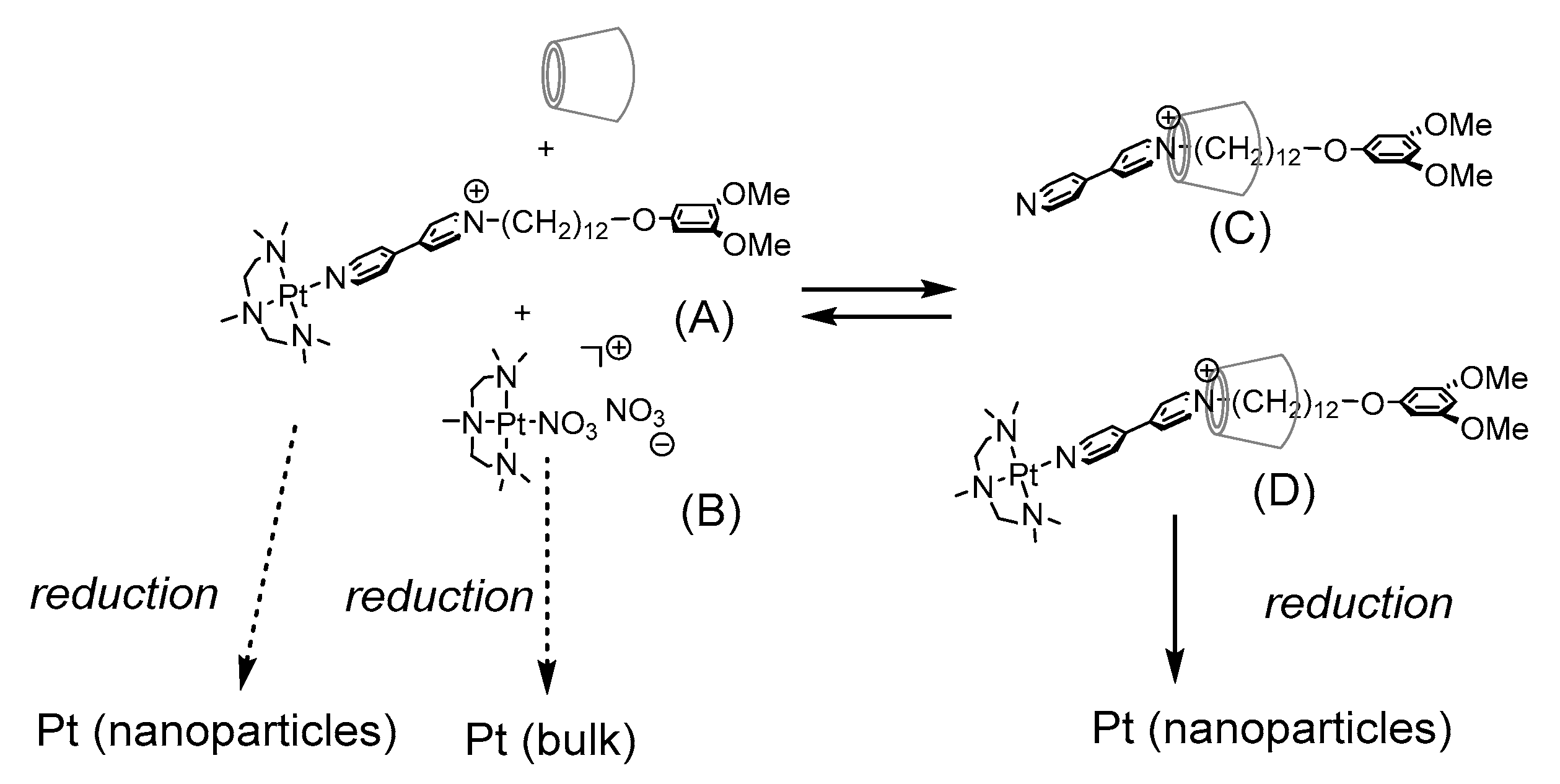

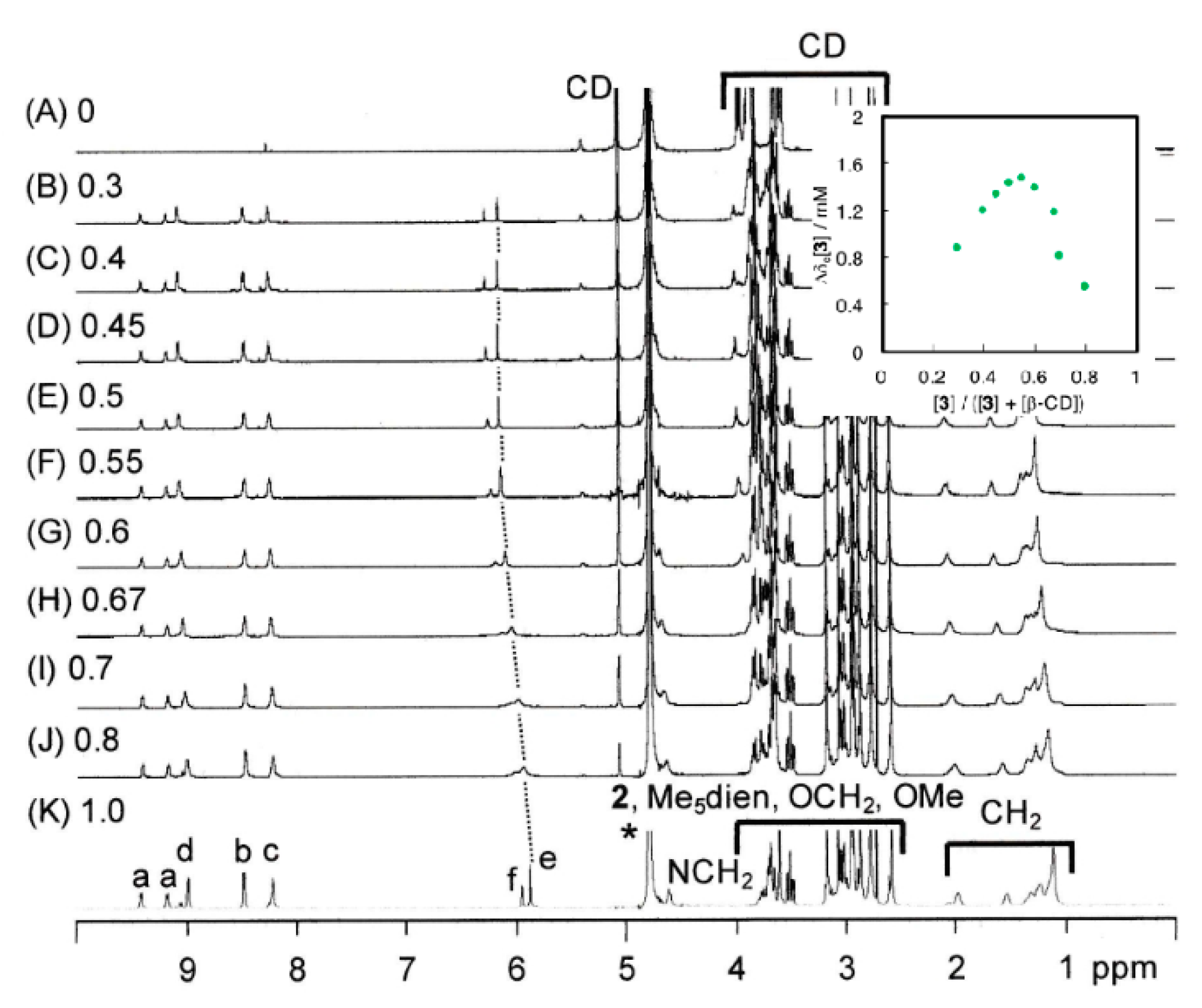

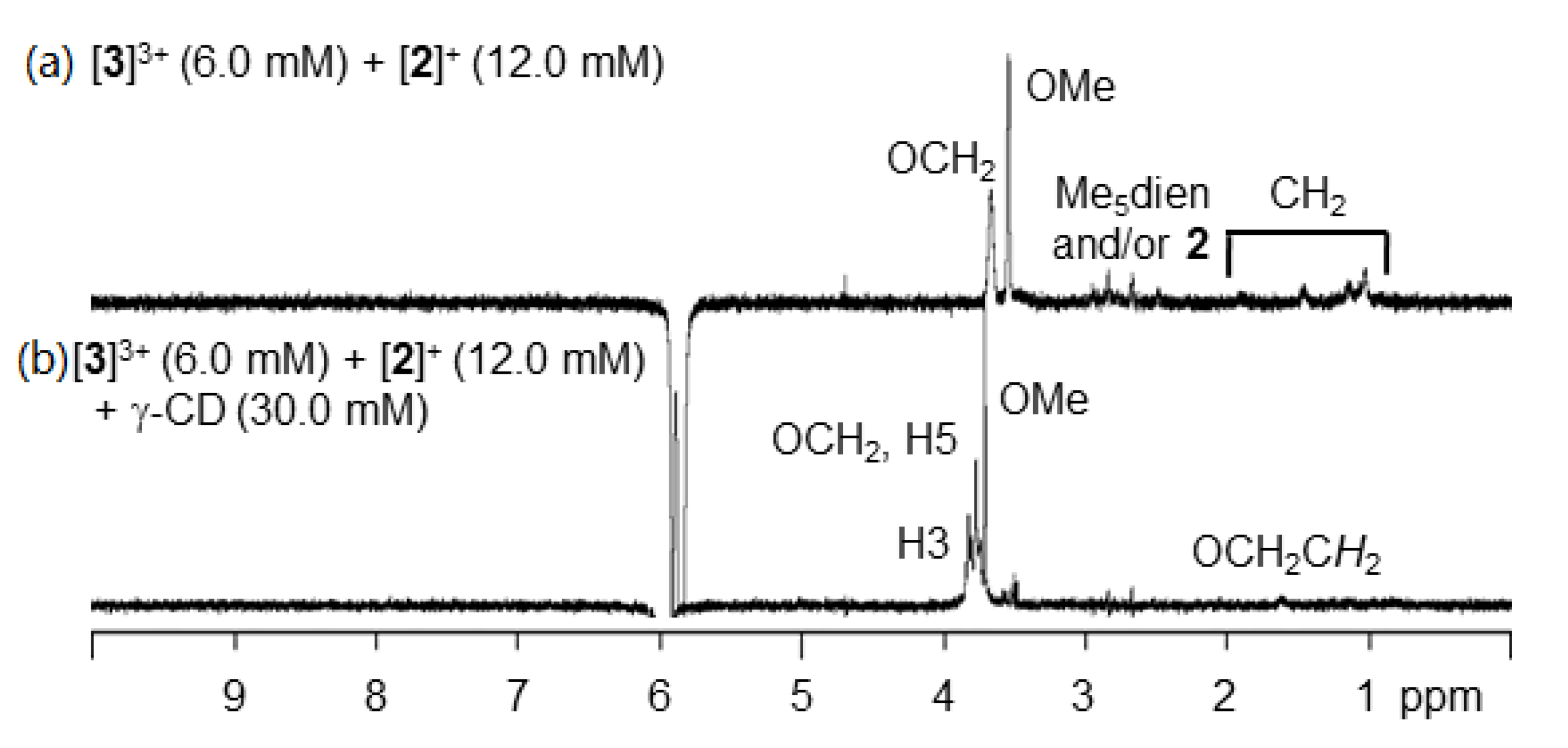
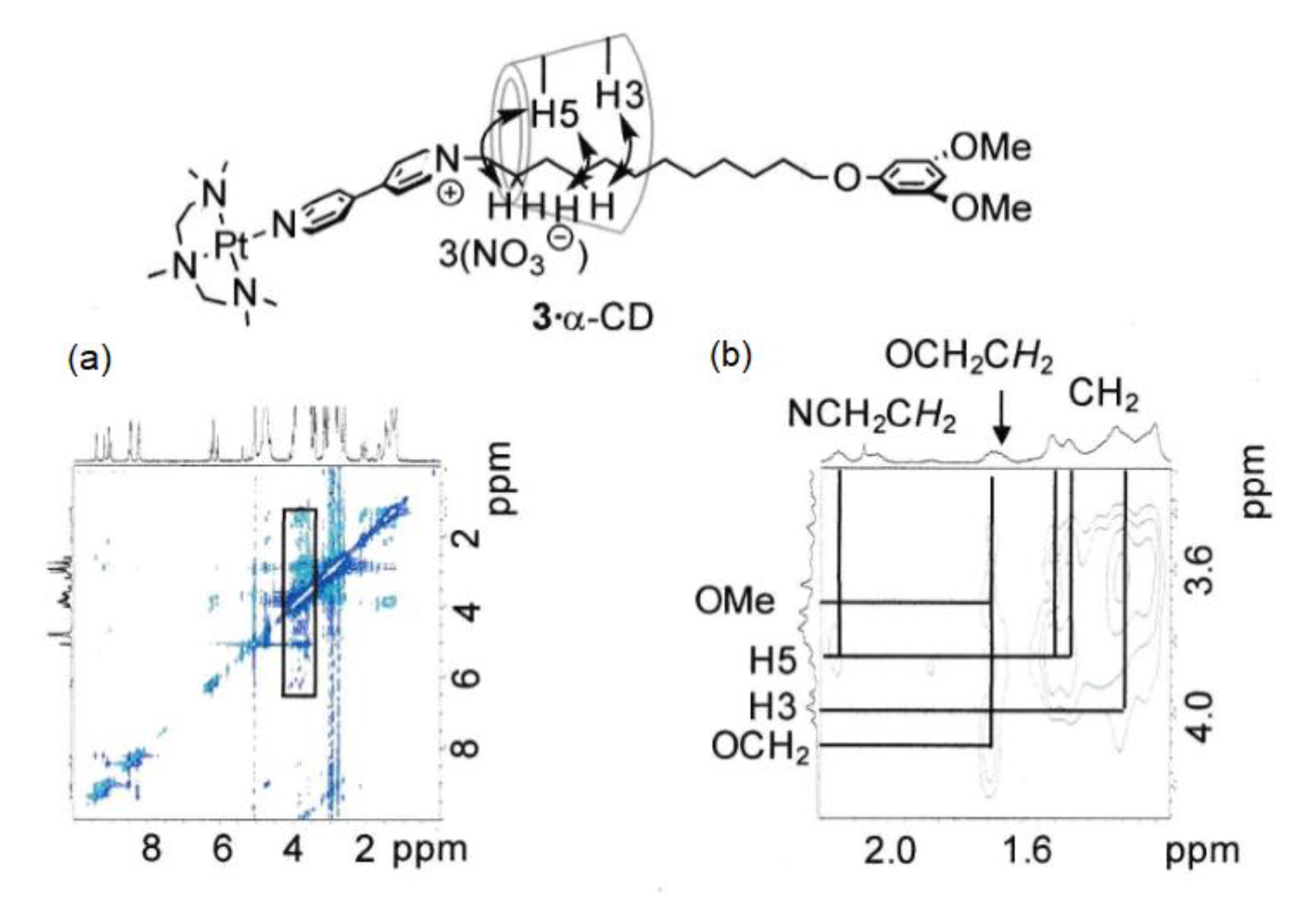
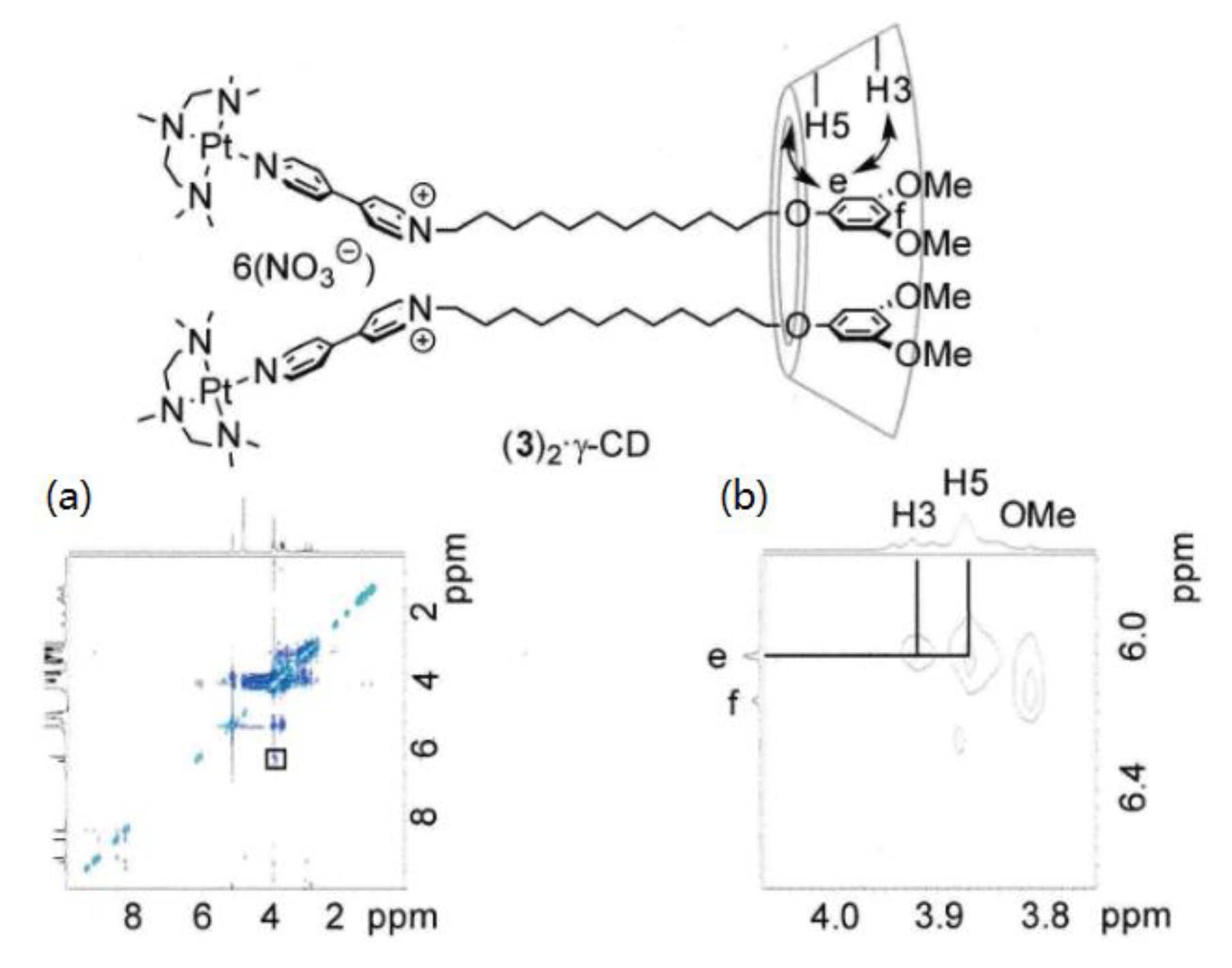
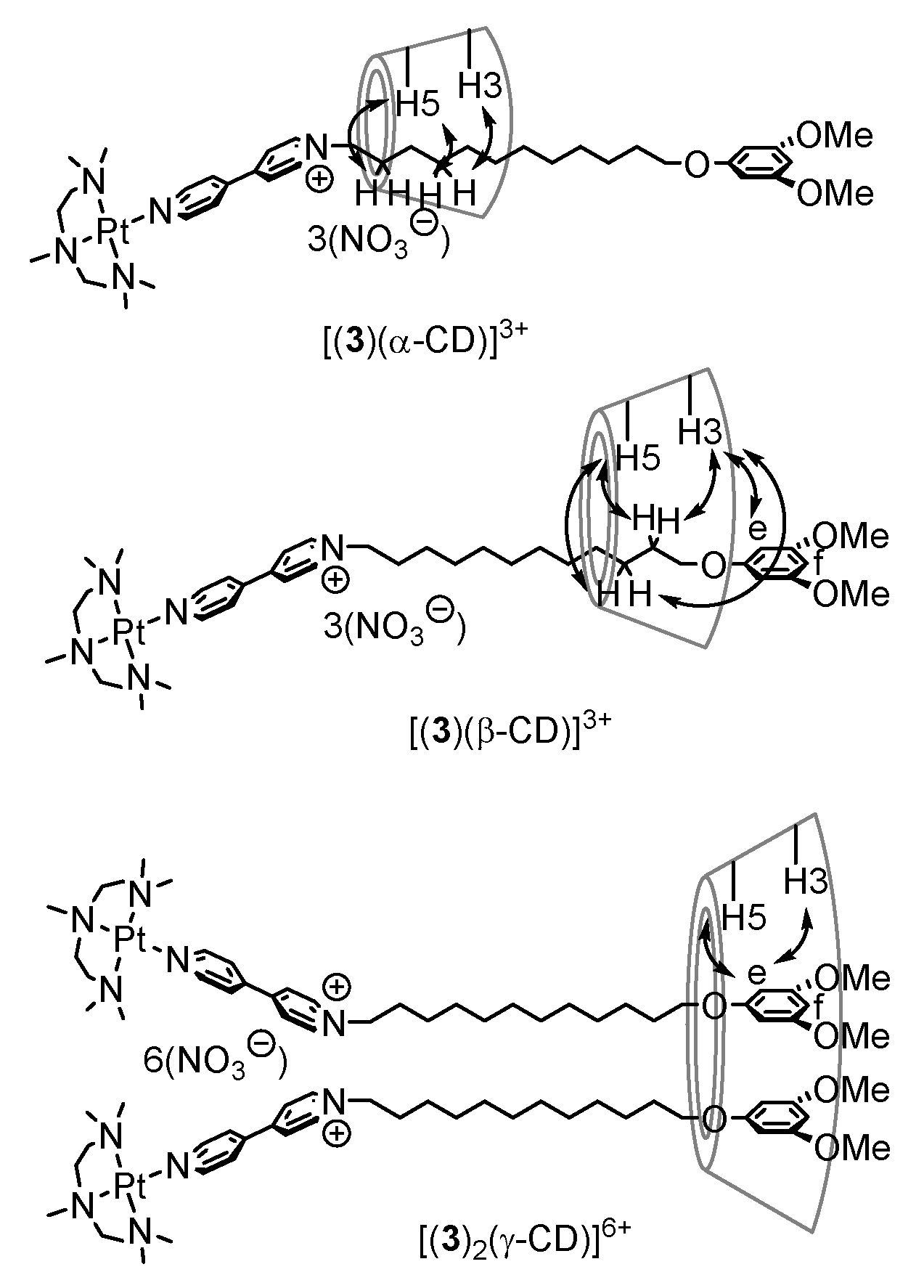

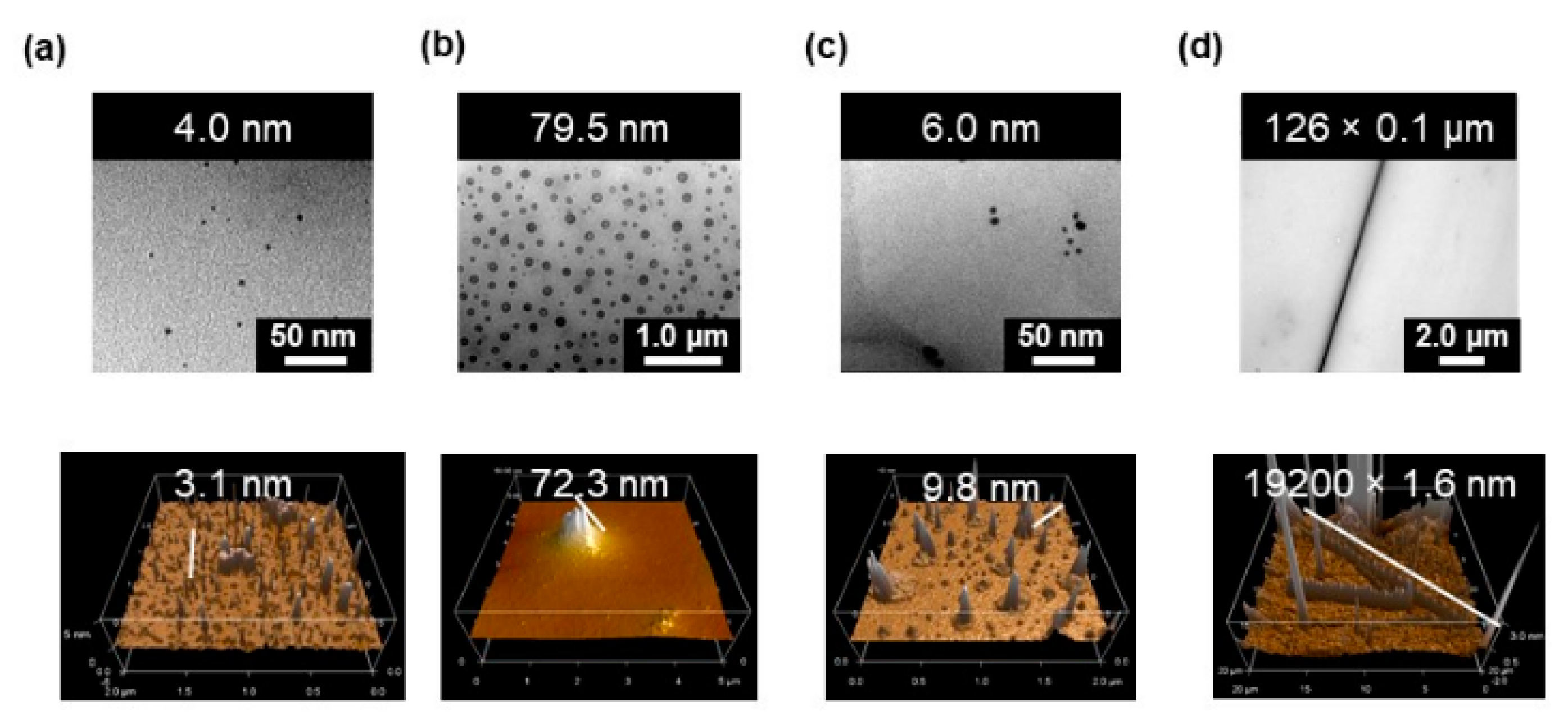
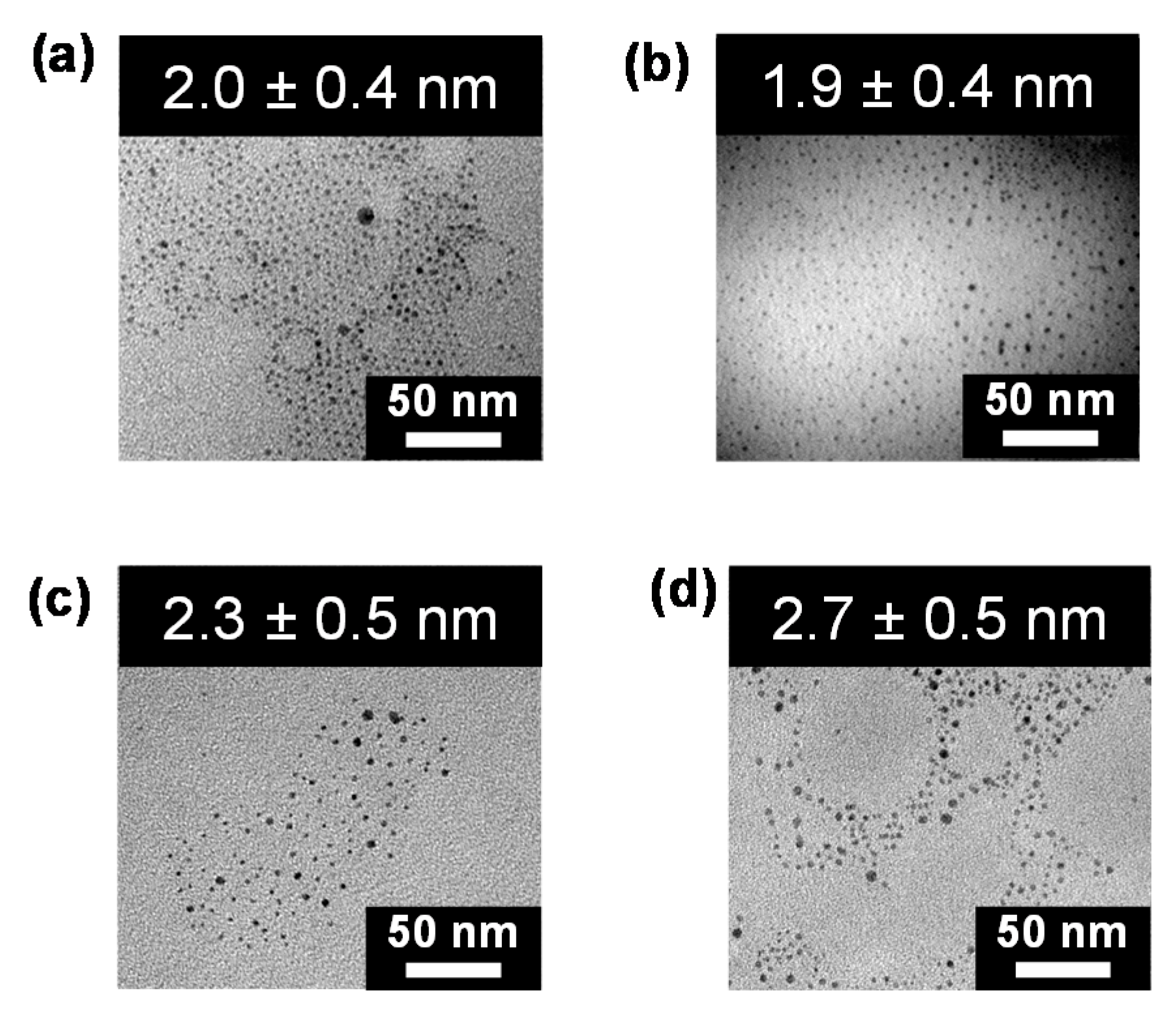
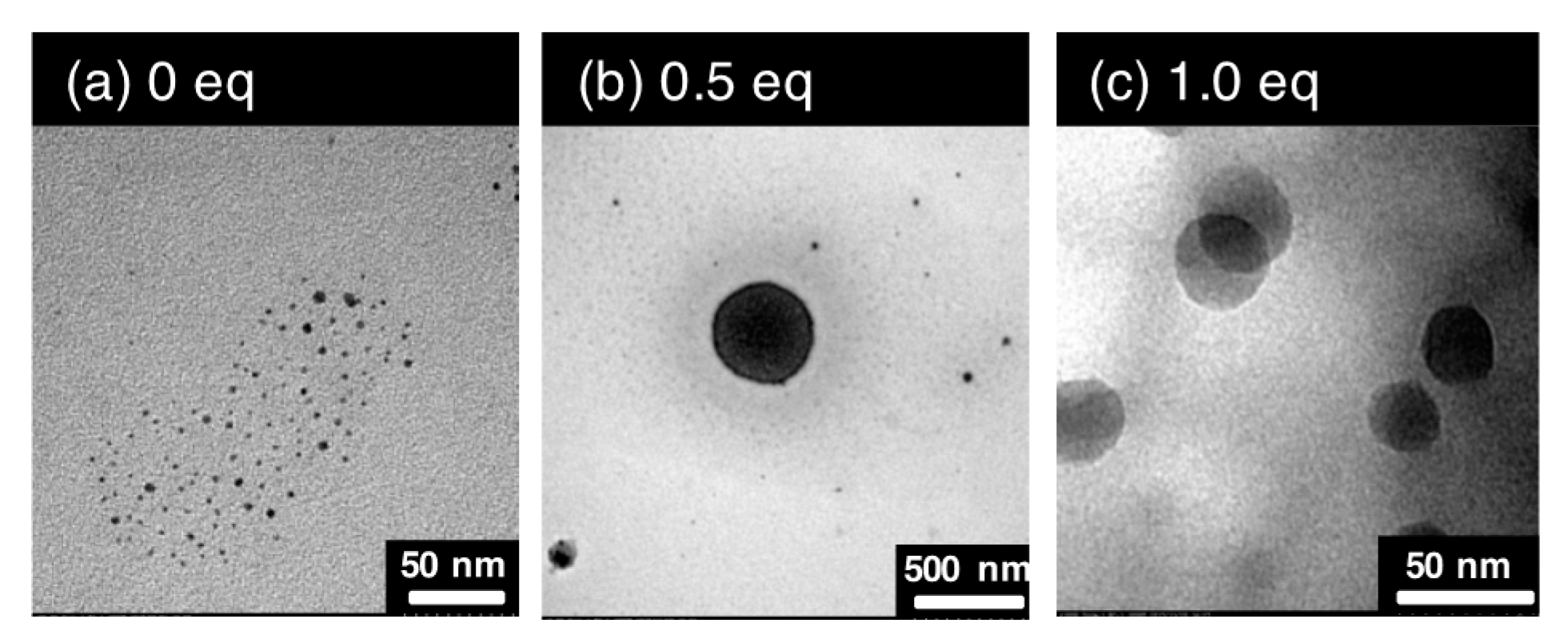
Publisher’s Note: MDPI stays neutral with regard to jurisdictional claims in published maps and institutional affiliations. |
© 2020 by the authors. Licensee MDPI, Basel, Switzerland. This article is an open access article distributed under the terms and conditions of the Creative Commons Attribution (CC BY) license (http://creativecommons.org/licenses/by/4.0/).
Share and Cite
Suzaki, Y.; Fujii, Y.; Osakada, K. Cyclodextrin Rotaxanes of Pt Complexes and Their Conversion to Pt Nanoparticles. Molecules 2020, 25, 5617. https://doi.org/10.3390/molecules25235617
Suzaki Y, Fujii Y, Osakada K. Cyclodextrin Rotaxanes of Pt Complexes and Their Conversion to Pt Nanoparticles. Molecules. 2020; 25(23):5617. https://doi.org/10.3390/molecules25235617
Chicago/Turabian StyleSuzaki, Yuji, Yuhei Fujii, and Kohtaro Osakada. 2020. "Cyclodextrin Rotaxanes of Pt Complexes and Their Conversion to Pt Nanoparticles" Molecules 25, no. 23: 5617. https://doi.org/10.3390/molecules25235617
APA StyleSuzaki, Y., Fujii, Y., & Osakada, K. (2020). Cyclodextrin Rotaxanes of Pt Complexes and Their Conversion to Pt Nanoparticles. Molecules, 25(23), 5617. https://doi.org/10.3390/molecules25235617




